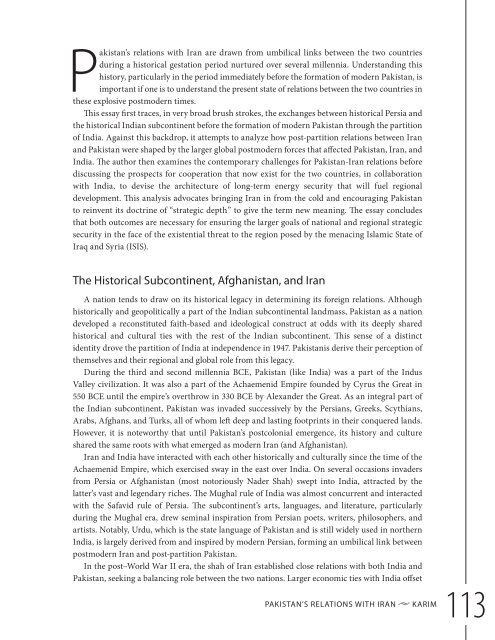pakistan’s
SR55_Mapping_Pakistan_February2016
SR55_Mapping_Pakistan_February2016
You also want an ePaper? Increase the reach of your titles
YUMPU automatically turns print PDFs into web optimized ePapers that Google loves.
Pakistan’s relations with Iran are drawn from umbilical links between the two countries<br />
during a historical gestation period nurtured over several millennia. Understanding this<br />
history, particularly in the period immediately before the formation of modern Pakistan, is<br />
important if one is to understand the present state of relations between the two countries in<br />
these explosive postmodern times.<br />
This essay first traces, in very broad brush strokes, the exchanges between historical Persia and<br />
the historical Indian subcontinent before the formation of modern Pakistan through the partition<br />
of India. Against this backdrop, it attempts to analyze how post-partition relations between Iran<br />
and Pakistan were shaped by the larger global postmodern forces that affected Pakistan, Iran, and<br />
India. The author then examines the contemporary challenges for Pakistan-Iran relations before<br />
discussing the prospects for cooperation that now exist for the two countries, in collaboration<br />
with India, to devise the architecture of long-term energy security that will fuel regional<br />
development. This analysis advocates bringing Iran in from the cold and encouraging Pakistan<br />
to reinvent its doctrine of “strategic depth” to give the term new meaning. The essay concludes<br />
that both outcomes are necessary for ensuring the larger goals of national and regional strategic<br />
security in the face of the existential threat to the region posed by the menacing Islamic State of<br />
Iraq and Syria (ISIS).<br />
The Historical Subcontinent, Afghanistan, and Iran<br />
A nation tends to draw on its historical legacy in determining its foreign relations. Although<br />
historically and geopolitically a part of the Indian subcontinental landmass, Pakistan as a nation<br />
developed a reconstituted faith-based and ideological construct at odds with its deeply shared<br />
historical and cultural ties with the rest of the Indian subcontinent. This sense of a distinct<br />
identity drove the partition of India at independence in 1947. Pakistanis derive their perception of<br />
themselves and their regional and global role from this legacy.<br />
During the third and second millennia BCE, Pakistan (like India) was a part of the Indus<br />
Valley civilization. It was also a part of the Achaemenid Empire founded by Cyrus the Great in<br />
550 BCE until the empire’s overthrow in 330 BCE by Alexander the Great. As an integral part of<br />
the Indian subcontinent, Pakistan was invaded successively by the Persians, Greeks, Scythians,<br />
Arabs, Afghans, and Turks, all of whom let deep and lasting footprints in their conquered lands.<br />
However, it is noteworthy that until Pakistan’s postcolonial emergence, its history and culture<br />
shared the same roots with what emerged as modern Iran (and Afghanistan).<br />
Iran and India have interacted with each other historically and culturally since the time of the<br />
Achaemenid Empire, which exercised sway in the east over India. On several occasions invaders<br />
from Persia or Afghanistan (most notoriously Nader Shah) swept into India, attracted by the<br />
latter’s vast and legendary riches. The Mughal rule of India was almost concurrent and interacted<br />
with the Safavid rule of Persia. The subcontinent’s arts, languages, and literature, particularly<br />
during the Mughal era, drew seminal inspiration from Persian poets, writers, philosophers, and<br />
artists. Notably, Urdu, which is the state language of Pakistan and is still widely used in northern<br />
India, is largely derived from and inspired by modern Persian, forming an umbilical link between<br />
postmodern Iran and post-partition Pakistan.<br />
In the post–World War II era, the shah of Iran established close relations with both India and<br />
Pakistan, seeking a balancing role between the two nations. Larger economic ties with India offset<br />
PAKISTAN’S RELATIONS WITH IRAN u KARIM<br />
113



